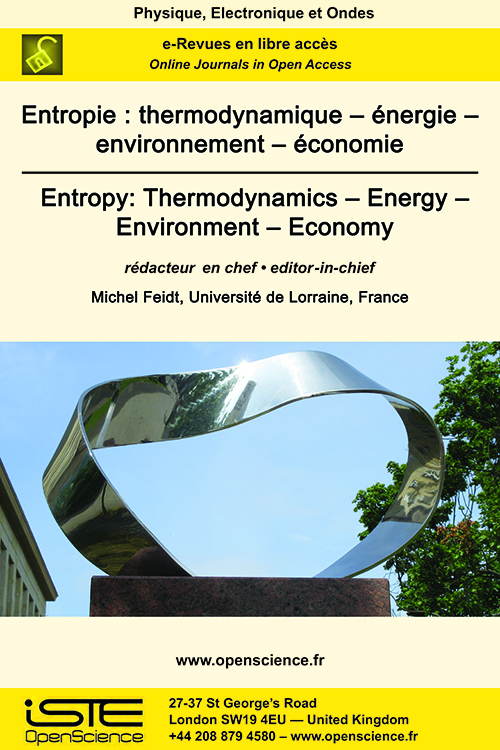

Physics > Home > Entropy: Thermodynamics – Energy – Environment – Economy > Issue
Physical systems materializing a bit of memory have recently been the subject of experiments to explore the link between information and entropy or to realize Maxwell’s demons. Whether microscopic (single electron, molecule) or mesoscopic (glass bead, colloidal particle, nano-magnet) systems, their changes of state are the result of elementary transitions caused by thermodynamic fluctuations or by quantum tunnelling. From the probabilistic equations of these transitions we deduce directly the formulas of energy exchanges between the memory, the energy source which controls its state and the thermostat which surrounds it, avoiding a detour by the theory of information. The resulting theory explains all the experimental results of bistable and tilt memories. In particular, it shows a partial decoupling between the work provided by the energy source and the heat exchanged with the thermostat during the change of state, as well as the influence of the speed of operations on the energies involved and on the thermal dissipation. It brings to light the paradox of the temporality of entropy, which had been evoked by Landau and Lifshitz, namely that entropy is not independent of time, more precisely that the value of entropy at this energy scale depends on the duration retained for its evaluation. It explains why it is possible to create or to delete a bit of information with an energy well below Kb T log2, the Landauer limit, and it completely solves the enigma of the Szilard’s machine.
At low ambient temperatures, the heating capacity and coefficient of performance of a single stage vapour compression heat pump cycle is significantly getting reduced. A two-stage cascade heat pump cycle operating with two different refrigerants provides a sustainable solution to lift the condenser temperature above 70 ℃. Calculation of thermal performance for various refrigerants pairs has been carried out by using Engineering Equation Solver software. The following refrigerants pairs R410A/R290, R410A/R1234yf, R410A/R134a, R410A/R407C, R32/R290, R32/R1234yf, R32/R134a, R32/R407C, R404A/R290, R404A/R1234yf, R404A/R134a, R404A/R407C, R744/R290, R744/R1234yf, R744/R134a, R744/R407C for low and high-temperature cycles have been tested numerically. R32/R134a and R410A/R134a shows the highest vapour compression cycle COP 1.98 from -30 ℃ ambient air temperature and +60 ℃ heating circuit temperature range, but they will be eventually suppressed in near future by Paris Agreement. As an environmentally friendly alternative to the previous pairs in the cascade cycle, R32/R290 and R744/R290 working fluids combinations are proposed.
For about two years, we have been suffering from the effect of the SARS-COV-2 pandemic [Covid-19]. Distraught, politicians in their speeches have gone from the theme of an ordinary flu, without major effects, to more credible prevention obligations, sometimes with delay. France counts today more than 130,000 deaths! All the society (including scientists), in the ambient vagueness, added its vision and its own proposals, which did not arrange anything. By using (for the most part) methods of solving classical differential equations, we find most of the couplings between viruses (growth, exposure, disappearance) and individuals (sick, immunized, etc.), already scientifically validated. Trends resulting from this semi-quantitative modeling validate a number of effects: social distancing, barrier gestures, mask efficiency, interest in teleworking, etc. On the other hand, in spite of the political rhetoric, validated by its scientific council, it is possible that vaccination will not serve to reduce the pandemic if the vaccinated (protected from the most serious effects) re-emit the virus, even in small quantities. Similarly, the existence of a collective immunity is not proven...
Spraying water in air improves air-cooling capacity, which then relies on the evaporation of water. Even for small drop sizes, literature reports that the evaporation remains limited inside the spray and below saturation limits. In this article, we describe the evolution of thermodynamic quantities in a mixture of air and evaporating liquid water. A complete and coherent formulation is used to express enthalpy, entropy and chemical potential. At constant enthalpy, we show that the chemical equilibrium corresponds to an intermediate state in which droplet evaporation is not complete and entropy is maximum under certain conditions. Results are compared with some experimental values measured in a wind tunnel downstream of a spray. The calculated values are consistent with observations. Cooling efficiency is discussed for the various parameters, which are the amount of water, air temperature and ambient humidity. Then, the numerical approach is inverted in order to forecast the amount of water needed to reach a target cooling temperature. This numerical approach is used to set water flow depending on inlet flow conditions and cooling objectives.

2025
Volume 25- 6
Issue 12024
Volume 24- 5
Special issue LILA 22023
Volume 23- 4
Issue 12022
Volume 22- 3
Issue 12021
Volume 21- 2
Special issue2020
Volume 20- 1
Issue 1